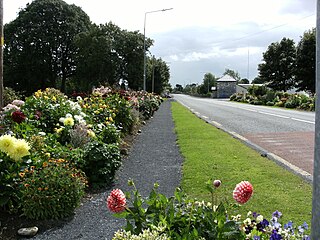
County Mayo is a county in Ireland. In the West of Ireland, in the province of Connacht, it is named after the village of Mayo, now generally known as Mayo Abbey. Mayo County Council is the local authority. The population was 137,231 at the 2022 census. The boundaries of the county, which was formed in 1585, reflect the Mac William Íochtar lordship at that time.

Connacht, is one of the four provinces of Ireland, in the west of Ireland. Until the ninth century it consisted of several independent major Gaelic kingdoms.

Newport, historically known as Ballyveaghan and for many years also known as Newport-Pratt, is a small town in the barony of Burrishoole, County Mayo, Ireland. The population was 626 in 2016. It is located on the west coast of Ireland, along the shore of Clew Bay, north of Westport. The N59 road passes through the town. The county town of Castlebar is approx 18 km east of Newport. The Black Oak River flows through the centre of the town and there are walking paths along its banks.

O'Dowd is an Irish Gaelic clan based most prominently in what is today County Mayo and County Sligo. The clan name originated in the 9th century as a derivative of its founder Dubda mac Connmhach. They descend in the paternal line from the Connachta's Uí Fiachrach. The immediate progenitors of the O'Dowd were Kings of Connacht during the 7th and 8th centuries in the form of Dúnchad Muirisci, Indrechtach mac Dúnchado, Ailill Medraige mac Indrechtaig and Donn Cothaid mac Cathail, before losing ground to their rivals the Uí Briúin.

Partry is a village and a civil parish formerly called Ballyovey in County Mayo, Ireland. It is located at the junction of the N84 and R330 roads between the towns of Ballinrobe and Castlebar, and between Lough Carra and Lough Mask. The lakes Cloon Lough and Lough Nacorralea are located near Partry.

Straide, or Strade, is a village in County Mayo, Ireland. It is located on the N58 national secondary road between Foxford and Castlebar. The name Strade is an anglicisation of the Irish words an tsráid, meaning the street.

The Conmhaicne were a people of early Ireland, perhaps related to the Laigin, who dispersed to various parts of Ireland. They settled in Connacht and Longford, giving their name to several Conmaicne territories. T. F. O'Rahilly's assertion the Conmaicne were non-Goidelic is not widely accepted.

Nephin or Nefin, at 806 metres (2646 ft), is the highest standalone mountain in Ireland and the second-highest peak in Connacht, Ireland. It is to the west of Lough Conn in County Mayo. Néifinn is variously translated as meaning 'heavenly', 'sanctuary', or "Finn's Heaven".

Lough Carra is a limestone lake (marl) of 4,000 acres (16 km2), in County Mayo, Ireland, about 8 miles (13 km) south of Castlebar. It is approximately 6 miles (9.7 km) long and varies in width from 400 yards (370 m) to one mile (1.6 km). The average depth is 6 feet (1.8 m), with a maximum of 60. It drains into Lough Mask via the Keel River.

The Uí Briúin were a royal dynasty of Connacht. Their eponymous apical ancestor was Brión, son of Eochaid Mugmedon and Mongfind, and an elder half brother of Niall of the Nine Hostages. They formed part of the Connachta, along with the Uí Fiachrach and Uí Ailello, putative descendants of Eochaid Mugmedon's sons Fiachra and Ailill. The Uí Ailello were later replaced as the third of the Three Connachta, through genealogical sleight of hand, by the Uí Maine.

Islandeady is a village in County Mayo, Ireland, about halfway between the towns of Castlebar and Westport.

The Partraige were a people of early historic Ireland.

Moore Hall, or Moorehall, the house and estate of George Henry Moore and family, is situated to the south of the village Carnacon in the barony of Carra, County Mayo in a karst limestone landscape.
The Uí Fiachrach were a royal dynasty who originated in, and whose descendants later ruled, the coicead or fifth of Connacht at different times from the mid-first millennium onwards. They claimed descent from Fiachrae, an older half-brother of Niall Noigiallach or Niall of the Nine Hostages. Fiachrae and his two full brothers, Brion and Ailill, were the collective ancestors of the Connachta dynasty that eventually became the new name of the province. Their mother was Mongfind.

Carnacon or Carrownacon is a village, townland and area in central County Mayo, Ireland. It is situated about 12 miles (19 km) from Castlebar, and is about 8 miles (13 km) from Claremorris and Ballinrobe.
Flann Ó Tighearnaigh (IPA:[ˈfˠl̪ˠaːn̪ˠoːˈtʲɪjəɾˠn̪ˠiː]), Gaelic-Irish Lord, died 1273.
There is little remaining of Doon Castle, situated on a hill in the townland of the same name, in the parish of Aughagower approximately four miles from Westport in County Mayo.
The Conmhaícne Ceara or Conmaicne Cúile Ceara were an early people of Ireland. Their tuath comprised some or all of the barony of Carra, County Mayo.
















